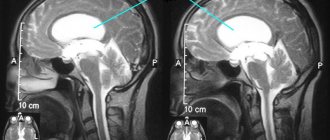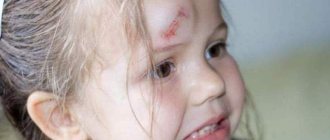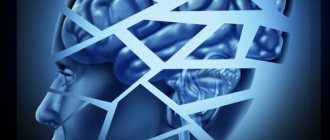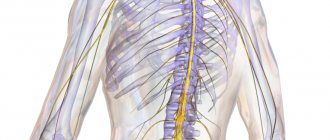From simple to complex
The baby’s nervous system develops in stages, becoming more and more complex every day.
Approximately on the 15th day after conception, the first nerve cells are formed, which will subsequently control the entire body. The development of the brain and spinal cord, as well as the entire nervous system of the child, begins with the formation of the neural tube. This is a strip of nerve cells that grows unevenly. In the head area it forms bubbles, which will then become the brain. In other parts of the body, the stripe bends - these are the future parts of the spinal cord. On the 22nd day after conception, the baby’s brain and spinal cord are not yet protected by anything3. The bones that form the skull and spine will appear later. But since the baby is still in your uterus and floating in the amniotic fluid, he is reliably protected from injuries and shocks. By the end of the first month, three brain vesicles can be seen in the baby’s head area: anterior, middle and posterior. In the sixth and seventh weeks, the anterior and posterior bubbles bifurcate and from three bubbles, five are obtained.
Subsequently, the anterior pair develops into the cerebral hemispheres and diencephalon (thalamus and hypothalamus). The middle cerebral vesicle will turn into the midbrain, to which nature has “entrusted” the performance of a large number of vital functions: it is responsible for vision, hearing, movement control, regulation of sleep and wakefulness cycles, orientation, protective and defensive reflexes, concentration, pain sensitivity, reproductive behavior and body temperature.
The hindbrain vesicle will become the rhomboid brain, the main functions of which are control of breathing and circulation, transmission of information from the spinal cord to the brain, coordination of movements, regulation of balance and muscle tone.
When the nervous system is formed, intrauterine development becomes a very delicate process, which is affected by any negative changes. Therefore, it is so important that you protect yourself from illness and stress, regularly undergo preventive examinations and listen to the advice of doctors. Visiting an obstetrician-gynecologist and following his recommendations is the key to ensuring that your baby develops properly and feels good from the first days of his intrauterine life4.
Modulation plasticity: the brain and its history
At this point we immediately encounter the second field of action of neuroplasticity - the modification of neural connections through modulation of synaptic effectiveness. Undoubtedly, it is at this level that plasticity manifests itself with the greatest brightness and strength, and it is here that it “reveals” its meaning. In fact, there is a kind of neural “creativity” that does not depend on anything other than the individual’s experience, life and interactions with the environment. This “creativity” is not assigned exclusively to the human brain, but is already characteristic of the most rudimentary nervous systems.
This plasticity, which consists of giving shape to branches and modulating synaptic effectiveness, was first identified by the Canadian neurologist Donald Olding Hebb. Donald Olding Hebb (1904–1985) is the author of the work “Organization of Behavior: A Neuropsychological Theory” (1949). The term “plasticity” was first proposed by the outstanding Polish neurologist Jerzy (Yuri) Konorski, whose vision of synaptic functioning was quite close to Hebb’s views (Konorski J. Conditioned Reflexes and Neuron Organization. Cambridge: Cambridge University Press, 1948; Konorski J. Integrative activity of the brain. M.: Mir, 1970).. At the end of the 1930s, various experimental observations forced him to move away from the concept of rigid localization of memory chains in accordance with Pavlov’s reflex arc model. In his opinion, one should rather talk about the existence of “plastic synapses” capable of adapting their transmission efficiency. Hebb formulated the hypothesis of neural circuits capable of self-organization, that is, modification of their connections during the activities necessary for perception and learning. The synapse is the primary site where neural activity can leave a trace that can displace, change, or transform itself through the repetition of past actions.
The ability of synapses to modulate their effectiveness and modify the intensity of their branches under the influence of experience occurs in two directions. Either the effectiveness of the synapse (its ability to transmit signals from neuron to neuron) increases - this is “long-term potentiation (LTP or LTP)”; or it decreases - this is “long-term depression (LTD or LTD).” This can already be seen in the example of such an animal as Aplysia. Its central nervous system is simple and consists of eight pairs of ganglia located around the esophagus and a large abdominal ganglion. Aplysia has a meager set of behavioral stereotypes, among which a number of defensive maneuvers can be distinguished, such as retracting the siphon or gills. At the same time, the strength of her protective reflex is modulated by experience. Repeating non-hazardous stimulation on the mantle causes a decrease in the reflex (habituation), which is expressed in a decrease in the amplitude of retreat movements. Habituation is accompanied by suppression of synaptic activity and a proportional decrease in the amount of neurotransmitter released at the level of the sensory-motor synapse. Neurotransmitters (acetylcholine, adrenaline, etc.) ensure the transfer of nerve impulses from one side of the synaptic cleft to the other. Here, electricity is replaced by chemistry (the principle of nerve signal transmission is electrical/chemical/electrical)..
The phenomena of long-term potentiation and depression are even more clearly expressed in the processes of adaptation, learning and memory in birds. For example, the black-capped chickadee stores food in pantries, which it then unerringly finds. Researchers were able to establish that the size of the brain zone (hippocampus) Since the hippocampal formation and parahippocampal gyrus play a primary role in the memorization process. The key to brain and behavioral plasticity is the ability to learn and remember. And the hippocampus is precisely the zone primarily responsible for these operations. Its damage has especially severe and most often irreversible consequences for cognitive activity and memory, which are involved in this process, in this bird more than in others that do not have experience in storing food. Therefore, species that practice storage have a significantly larger hippocampus in comparison with others. This change is a consequence of the accumulation of new neurons, decreased cell death (apoptosis), and increased connections between hippocampal neurons. The latter thus demonstrates amazing structural plasticity.
Potentiation and depression are not simply synaptic processes during which one or more stimulations produce immediate excitation. These are also long-term modifications that can transform the form (changes in the size of a certain brain area, varying the permeability of a regularly excited area) and remove a trace in order to reapply it (lability of the memory trace). Indeed, it has been observed that some neural networks become more productive when they “suppress” synapses that were involved in tasks that led to errors in motor learning. In the human brain, this feature is clearly evident during all learning processes. For example, when learning to play the piano, a mechanism for suppressing input signals corresponding to erroneous movements (“misses”) makes it possible to learn correct movements. In the case of potentiated connections, synapses increase the area of contact, their permeability increases, and nerve conduction accelerates. Conversely, a synapse that is underused or "suppressed" tends to become less productive. Neurons store stimulation impulses in some way. It is as if the stabilization of memories occurred solely under the condition of a potential destabilization of the overall landscape of memory.
So, long-term potentiation is structurally related to long-term depression. If synapses, and especially hippocampal synapses, did nothing but strengthen under the influence of LTP, they would soon all reach the maximum degree of efficiency and, therefore, the encoding of new information would be impossible, and this connection would be impossible. constitutes a differentiating, or rather, transdifferentiating force of neuroplasticity. If we use the analogy with the formation of stem cells, we can assume that, due to their plasticity, neural connections are always able to change a difference, perceive an imprint or get rid of it, and transform their program.
Hence,
The fact that synapses show increased or decreased effectiveness as a function of experience suggests that, although the anatomy of the brain is the same in all people, no brain is identical in history to another.
This is directly evidenced by the phenomena of learning and memory. Repetition and habit play an essential role, which means that the neural chain never has a clearly fixed response. Plasticity combines the role of the sculptor with the functions of the artist and educator of freedom and autonomy. In a sense, it is plausible to say that synapses represent the brain's reserves for the future. They are not fixed and do not serve as mere transmitters of neural information, but they have the power to shape or reform that information itself. Marc Genreau writes: “The effectiveness of synapses varies depending on the flow of information that passes through them: each of us, in childhood and throughout our lives, experiences a unique configuration of environmental influences that is reflected in the shape and function of our brain networks.”
This once again calls into question the old dogma that the adult brain tends to lose its plasticity - it is, of course, able to accumulate new information, but there is no change in its learning, memory functions and global structure, except perhaps to the side. decline or degeneration. On the contrary, we see that there is a constant restructuring of neural morphology.
What is your baby learning?
In the sixth and seventh weeks of pregnancy, in parallel with the brain and spinal cord, the child’s peripheral nervous system is formed: in it the largest cranial nerves can already be distinguished5. They are needed so that the baby’s brain quickly collects and processes information received from all parts of his body. By this time, other large organ systems begin to develop: the heart beats, the liver creates the first blood cells, and the kidneys grow. Also, the child’s arms and legs grow, eyes and ears form, the baby is already becoming like you. Every day he improves more and more, constantly learning new things.
In the second trimester of pregnancy, development continues: the baby already hears your voice and all external noises, and actively explores his body and the environment with his hands. He touches the umbilical cord, sucks his thumb, and develops the reflexes necessary for the future. He coordinates the movements of his limbs and trains daily. You can already feel his rhythmic kicks and thrusts from within. Also in the second trimester, the baby begins to open his eyes, now he may be frightened by bright light and shudder.
The second trimester also begins the process of myelination. This is “protective isolation” for each nerve, it improves its functioning so that your baby quickly learns new things. By the time of birth, the process of myelination is not completely completed; it continues during the first years of the child’s life. In the fifth month of pregnancy, the cerebral hemispheres are still smooth, but when your baby is born, they will already have convolutions and grooves.
3. Restorative plasticity: the brain and its regeneration
Here we come to consider the third field of action of plasticity - restoration. The term "restorative plasticity" actually refers to two different processes: neuronal renewal, or secondary neurogenesis, and the brain's ability to repair some types of damage caused by injury.
What is meant by “neuronal renewal” or “secondary neurogenesis”? From what we have just said, it appears that the first plasticity, morphogenetic, is followed by modulation plasticity, which modifies synaptic effectiveness but does not affect the anatomical stability of the brain, as if it were operating, so to speak, within a closed system. According to Heather Cameron: “Some scientists still adhere to the stable brain hypothesis, according to which there is no anatomical plasticity of the adult brain, and especially the cerebral cortex; They believe that the functional plasticity underlying learning mechanisms involves changes in the “power” of synapses produced by modification of receptors or the intercellular environment of neurons at the molecular level." Heather Cameron is a researcher in the laboratory of molecular biology of the National Institute of Neurological Disorders and Stroke (NINDS / NIH) in Bethesda, USA. We quote her article: Cameron H. Naissance des neurones et mort d'un dogme // La Recherche, No. 329, Mars 2000. P. 35.. However, this dogma of a stable brain is not entirely true. Indeed, the author continues,
“We now know that individual neurons in areas important for learning are constantly being updated—and this amounts to relatively significant anatomical changes.”
Even if the role of stem cells in the adult brain and their localization are still poorly understood, and even if there is a possibility that secondary neurogenesis does not affect all regions of the brain, it is undeniable that nerve cells are renewed in adulthood. This opens up unprecedented prospects for brain restoration and changes our understanding of its functioning.
A recent study of the primate neocortex revealed the presence of new neurons in three regions of the association cortex: the prefrontal, inferior temporal, and parietal areas. “This result is particularly interesting because the association cortex plays an important role in high-level cognitive functions, while the striate cortex [which does not show updating] is involved in processing visual information. This difference suggests that while neurogenesis plays a key role in functions that are inherently plastic, it is not beneficial for lower-level functions such as sensory processing, which are typically stable throughout life.”
The production of new neurons is thus not simply about replacing dying cells. It plays a role in the plasticity of modulation and, because of this, further expands the concept of plasticity - to the point of shaking the concept of stability. Again: the statue comes to life, the program becomes animated. Where, as it seems to us, there is only pure mechanics, we find a complex interweaving of different types of plasticity, contradicting the usual ideas about the brain as a machine. As Alain Proshyants states: “It must be said that one of the main characteristics of the nervous system, of course, lies in its plasticity. The brain cannot be viewed as a network of finally laid cables, and brain aging cannot be viewed as the disconnection of an ever-increasing number of elements of this chain from the network. Even though this has only been formally proven in a few experimental models, we have the right to assume that nerve fibers grow daily, that some synapses disintegrate, while others, new ones, are formed. These changes in the neural landscape... are a testament to our adaptability, our ability to learn, and our potential for improvement, which continues into old age and, in fact, until death.”
In a paper titled “The Unusual Distribution of New Neurons,” the researchers state: “…observations of secondary neurogenesis clearly show that the adaptive capabilities of the nervous systems of birds and adult mammals do not arise solely from variability in synaptic connections. They also rely on the production or renewal of distinct populations of neurons in several highly defined regions, the common property of which is to perform functions responsible for learning and/or memory. In this light, it appears that secondary neurogenesis similarly allows the subject's personal experiences to leave their mark on neural networks in the form of regular morphological and functional rearrangements. This means that adult neurogenesis, as the ultimate mechanism of plasticity, largely controlled by the subject’s personal experience and its interactions with the environment, apparently constitutes an additional mechanism of individuation. With the significant difference that it lasts throughout life.”
The idea of cellular renewal, regeneration, resource as an aid to synaptic plasticity sheds light on the power of healing - healing, healing, compensation, restoration, the brain's ability to create natural "prostheses". The plastic art of the brain gives birth to a statue capable of healing itself. The functioning of the brain, as we know, can be impaired due to many pathologies, the most famous of which are traumatic brain injuries, cerebrovascular accidents, encephalitis, neurodegenerative diseases (Parkinson's disease, Alzheimer's disease). At the same time, after such injuries and illnesses, the nervous system invariably shows plasticity, regardless of whether its efforts are crowned with success or not: the affected structures and functions try to modify themselves in order to compensate for the deficiency or form a new organizational pattern that simultaneously deviates from the norm and restores it .
Restorative plasticity obviously does not compensate for all deficits. Some lesions, as we know, are irreversible. But at first, the brain always tries to reorganize the affected function with greater or less effectiveness, efficiency and reliability. As an example of this phenomenon, Marc Janreau cites “paralysis of the left arm caused by damage to the motor cortex on the right due to a stroke. At first, no movement is possible, the hand is motionless and lethargic. After some time, muscle strength returns and mobility of the elbow and wrist is restored. How is this possible if the neurons responsible for controlling these movements are destroyed?... Here functional neuroimaging comes to the rescue: it shows that when the patient tries to move the paralyzed arm, it is the unaffected motor cortex on the left that is activated. The patient, either by himself or through rehabilitation, learns to use neural pathways that normally do not exist. Such a reorganization of motor function once again indicates the plasticity of cerebral mechanisms.” Another example is what happens in the early stages of Alzheimer's disease. The onset of amnesia is partially compensated by the ability to restore stored information. The deactivation of some regions (hippocampus) is balanced by the metabolic activation of others (frontal). Thus,
damage to individual circuits is followed by a change in information processing strategies, which also indicates functional plasticity of the brain.
So, the human brain has functions responsible for reorganization after damage. These phenomena are also observed in some transplants. In January 2000, staff at the Edouard Herriot Hospital in Lyon performed the first hand transplant on thirty-three-year-old Denis Chatelier, who had suffered an amputation after an accidental explosion three years earlier. The question was: even if it is possible to establish anatomical continuity between the donor's hands and the recipient's forearms, can the same continuity be achieved at the psychological and neurological levels? The case of D. Sh. proved that yes. His phantom pain disappeared, and the motor progress he made suggested that his brain had successfully integrated the transplanted arms. “When the motor cortex reorganizes, the synapses are modified. They change their influence and “weight” in the local functioning of the network of neurons... After transplantation, [such] changes in neural connections could lead to the restoration of the representation of the hand.” Another proof of the amazing adaptability of our brain.
In the “Open Reading” section we publish excerpts from books in the form in which publishers provide them. Minor abbreviations are indicated by ellipses in square brackets. The author's opinion may not coincide with the opinion of the editors.
Where can you study on the topic #health?
Well
Course V.A. Dubynina “Immunity through the eyes of a physiologist”
October 15, 2021 – November 12, 2019
Well
Master's degree in Family and Marriage Therapy
September 1, 2021 – July 1, 2022
Well
First aid course
October 29, 2021 – November 27, 2019
Where can I study on the topic #brain?
Well
Multifunctionality of the brain
As you type
Well
Brain and addictions
As you type
Well
Brain development: useful activities
Scientists believe that listening to classical music, viewing works of art, reading books, and your gentle voice have a positive effect on the formation of a child’s nervous system. Try to develop your baby’s nervous system every free minute. Read as much as possible, including out loud, so that you can be heard, admire the beautiful, enjoy pleasant melodies. Your positive emotions are extremely important for the development of your child’s brain and entire nervous system.
After the 30th week, when maternity leave begins, you can plan a program of cultural events: visiting exhibitions, museums or field trips. However, consult your doctor and find out which activities should be excluded from the list. So, prolonged standing, climbing steep stairs or being in noisy rooms should be avoided.











